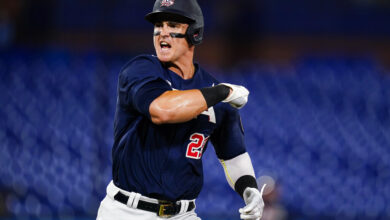
Awful Performance Against Lefties Could Influence Cubs’ Offseason Moves
The Cubs were so bad against lefty pitchers in 2020…How bad were they? The Cubs were so bad against lefties this past season, they made other bad teams look not bad. Though their aggregate .619 OPS was actually 10 points better than the Mariners, it was the lowest mark for any Cubs team in 101 years. And as Bryan Smith of Bleacher Nation points out, the ignominy is made worse by the fact that 2020 is the first season in which pitchers didn’t bat.
The 2020 Chicago Cubs, the first team in club history that didn’t have pitchers bat for themselves, had a .619 OPS against left-handed pitching. It was the worst OPS the organization posted against lefties in 101 years, since the 1919 Cubs had a .604 OPS against lefties.
— Cubs Prospects – Bryan Smith (@cubprospects) December 11, 2020
Only eight teams in MLB had an OPS of less than .700 against left-handed pitchers and the league average was .740, so it’s not as though a more systemic slump is to blame. The Cubs put up a .750 OPS against lefties in 2019 and .730 in 2018, much better than this past season but far worse than their .777 in 2017 and .807 during their title campaign.
To quote Theo Epstein for the thousandth time, the offense broke somewhere along the lines.
Only nine Cubs OPS’ed above .600 against lefties in 2020, but three of those had fewer than 15 plate appearances on the season. Steven Souza Jr. (.685) came in at sixth on the team while Billy Hamilton (1.667) and Ildemaro Vargas (1.250) led the way. Again, we’re talking about a combined total of 20 plate appearances for those three, fewer than any other individual hitter in the top 12. The performance of more regular players may give us clues as to the front office’s thinking this winter.

Kyle Schwarber‘s .597 OPS was almost certainly part of the equation when it came to the decision not to tender him a contract for next season. Though his performance was far worse than his .650 career mark, it’s less of an aberration than the .756 he posted in 2019. Taking away that high-water mark puts him much closer to .600 over his four other seasons (he didn’t bat against a lefty in 2016). While his overall offensive production has been solid, he was viewed as expendable because of the splits.
There have been rumblings about the Cubs possibly looking to move Willson Contreras, which would make sense in that he’s easily their most valuable trade chip. There’s also the matter of his .542 OPS vs. LHP, though I think we can all agree that was a total fluke when taking his .861 career mark into account. At the same time, the switch-hitting Victor Caratini OPS’ed .892 despite an overall disappointing campaign and historically hits lefties better than righties.
Making a move solely based on a small-sample split would be foolish, but it makes a little more sense if it’s more about the Cubs transitioning in 2021 and opening the door for top prospect Miguel Amaya after that. And in case you’re getting salty with me here, please remember that I’m not saying this is what the Cubs should do. Rather, I’m trying to connect some speculatory dots to see what they might do and why they might do it.
As unlikely as it seems that they’d move Javy Báez, his .654 OPS in 2020 was more than 200 points below his career mark and almost 300 points lower than his average from the three previous seasons. That’s way too much of an outlier to be indicative of anything other than a bounceback and the Cubs don’t have a replacement ready, but there’s still that notion of punting on next season.
Again, apply the right perspective here.
Awful Performance Against Lefties Could Influence Cubs’ Offseason Moves
Finally, we look to Kris Bryant and what was a forgettable campaign from a numbers perspective. However, his .821 OPS against lefties was second to Caratini among players with enough plate appearances to warrant discussion even though it was still significantly lower than in any season since 2015. Bryant’s .896 career OPS against lefties is seventh-highest in MLB since 2015 and his 1.033 mark since 2016 ranks third overall.
Jed Hoyer recently downplayed the presumed certainty that Bryant will be traded, leaving open the possibility that the former MVP could remain in town for a while. While Hoyer could merely be engaging in a little gamesmanship, a healthy Bryant diversifies the Cubs’ lineup and shores up weaknesses that were magnified over the course of the 60-game season.
I’m probably a few hundred words past the threshold for those who need to hear this and it’ll be redundant for those who already understand, but the notion that Bryant has regressed from an ability standpoint is complete bullshit. Injuries are solely to blame for any lack of production and labeling him “soft” is too stupid to dignify with further conversation. The potential for additional injuries and resultant recovery can’t be overlooked, but we’re talking about disparate acute issues and not chronic breakdown.
But uh, back to the lecture at hand, which is that Hoyer and his staff will be looking very strategically at how they can best leverage their limited resources to thread the needle this season. Improving against lefties will be part of that, along with the addition of a contact hitter or three as the market allows. Or maybe they’re really just going to spin off salaries and hope for the best in ’21 while eyeing ’22 and beyond as a whole new competitive window.
Either way, they’ve got to do better against southpaws to make it work.

